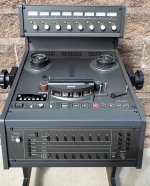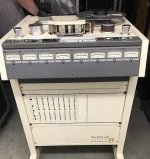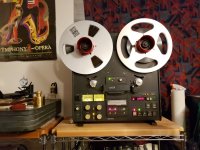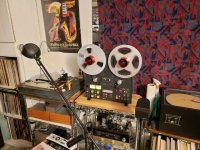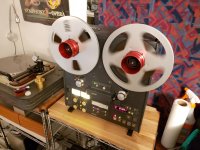After inspecting the schematic more closely, that does appear to be the case! WOW!! BP types are supposed to have lower distortion than polarized ones. Do you still think that they have deteriorated to the point of needing replacement? I know that regular electrolytics do age, but what about bipolar types?Almost all coupling caps in Otari decks are BP (bi-polar aka non-polar types). I use Nichicon Muse in the audio path and somewhat less expensive Nichicon BP types in the switching circuits. The MX-55 appears to have come with Nichicon Muse in the audio path by default.
Definitely true, and that's why I bought one. MUCH better than the Tascams of the day. My machine cost $5900 new!! The best 1/2" 8-track I could find in the day. Do you know if they made LATER 8-tracks than the MX-5050 MKIII-8 model? I've seen later 2 and 4 track machines, but not 8.These machines were pretty expensive in their heyday so they were a little better built than the typical consumer stuff.
Workhorses and not as sophisticated as the Studer stuff, but much easier to work on. (If I can do it, there are plenty of others who can too.)
<snip> Do you still think that they have deteriorated to the point of needing replacement? I know that regular electrolytics do age, but what about bipolar types?
The wear out mechanisms should be pretty similar to polar capacitors I'd think, and my experience so far is that it makes a pretty big difference in performance both subjectively and in the case of the MX-50s I have, functionally as well - they just stopped working because leaky bipolar caps disabled the mute circuitry and record switching in the N - replacing all of the caps and cleaning a pretty ugly looking goo off of the back of these boards has restored full functionality without need of any further trouble shooting. (Both of my 5050 had other problems in addition)
The N II awaits a full recap, and record and monitor functions no longer work, and it sounds a bit muddy compared to the N. I suspect like the N a recap will restore full functionality to this very nice looking apparently low hours machine. (The original lamps still work and the heads and tape path are pristine, not much wear at all.)
So I would recommend replacing them all. Signal bath with Muse and the rest with a good general purpose bipolar where called for.
I recapped almost entirely with Nichicon..
I have great curiosity about the MTR series and in particular the 10/12 and 15. These are the really high end Otari machines some with auto calibration and other rather interesting high end features.
The MTR -15 is probably going to be my next target when I am ready to experiment with something new.. It was easily cutting edge in its time. (It's also pretty rare)
Otari MTR-15 Mastering Tape Recorder
In the mean time I need to decide what to do with all of the decks I currently own. The MX-50 series seem best suited to my current needs.
The MTR -15 is probably going to be my next target when I am ready to experiment with something new.. It was easily cutting edge in its time. (It's also pretty rare)
Otari MTR-15 Mastering Tape Recorder
In the mean time I need to decide what to do with all of the decks I currently own. The MX-50 series seem best suited to my current needs.
The MTR-15 is a very interesting machine! I was not aware of it---do you know what year it came out? I have worked on the MTR-10/12 series, and they are fine machines indeed. A 1/2" 2-track MTR-15 would be killer!!I have great curiosity about the MTR series and in particular the 10/12 and 15. These are the really high end Otari machines some with auto calibration and other rather interesting high end features. The MTR -15 is probably going to be my next target when I am ready to experiment with something new.. It was easily cutting edge in its time. (It's also pretty rare)
Hmmmm....but Nichicon Muse caps aren't bipolar...eh?The wear out mechanisms should be pretty similar to polar capacitors I'd think, and my experience so far is that it makes a pretty big difference in performance both subjectively and in the case of the MX-50s I have, functionally as well - they just stopped working because leaky bipolar caps disabled the mute circuitry and record switching in the N - replacing all of the caps and cleaning a pretty ugly looking goo off of the back of these boards has restored full functionality without need of any further trouble shooting. (Both of my 5050 had other problems in addition)
So I would recommend replacing them all. Signal bath with Muse and the rest with a good general purpose bipolar where called for.
I recapped almost entirely with Nichicon..
Hmmmm....but Nichicon Muse caps aren't bipolar...eh?
Actually these are.. See data sheet.
Link to Muse Bipolars: Aluminum Electrolytic Capacitors | Capacitors | DigiKey
Attachments
I am not sure of exact dates for the MTR-15, but I believe it is pretty late. i.e. late 1990s if not later. I've never seen one. The model I am interested in is the 15N..
Edit:
Found this: Test Drive: The Otari MTR-15 2-track Recorder - Radio And Production
Seems like it arrived in the early 1990s. This may be the A-810 killer I have been looking for, seriously take a look. I'm really impressed.
Edit:
Found this: Test Drive: The Otari MTR-15 2-track Recorder - Radio And Production
Seems like it arrived in the early 1990s. This may be the A-810 killer I have been looking for, seriously take a look. I'm really impressed.
Thanks for the link! BiPolar they are! I notice that the higher voltage caps have less ESR, although slightly bigger and slightly more expensive. Which did you choose? Certainly no more than 25 volt rating is NEEDED, but the lower ESR is attractive. I'll have to see what will fit in my machine, I guess.Actually these are.. See data sheet.
Link to Muse Bipolars: Aluminum Electrolytic Capacitors | Capacitors | DigiKey
Yes, impressive. Don't know if it's a Studer killer. The Studers are very elegant machines, no doubt. And probably have some snob appeal, as well. Not sure how much performance advantage that brings. And I'll bet the Otari is much less $$$---eh?.....Seems like it arrived in the early 1990s. This may be the A-810 killer I have been looking for, seriously take a look. I'm really impressed.
Just looking at the data sheet I have, "mediocre" does not accurately describe the HA12017's PSRR---it is downright ****-poor! ON the negative rail, it's only -45db!! An LM4562 is -110db.I think that's the Hitachi HA12017 which is SIL-8 with a missing pin. It was intended for low noise RIAA preamps. I still use a pair in an old preamp I built in the 80's. Pretty quiet but very mediocre PSRR.
I have the datasheet / RIAA appnote if you want it.
I went mostly with 25V and 50V Muse. Modern caps have shrunk a bit since these machines were made and you should be able to fit higher voltage parts if their improved performance warrants it.
I've decided to go out on a limb, op-amps rated for max supply voltage of 44V are pretty rare, but necessary in a machine with +/-20V rails when its owner decided to keep the original supply voltages. Turns out there is one pretty good choice but now only available in SOIC, the LME49860, even part of the sound series from TI... Well I guess we'll see how that goes...
I've decided to go out on a limb, op-amps rated for max supply voltage of 44V are pretty rare, but necessary in a machine with +/-20V rails when its owner decided to keep the original supply voltages. Turns out there is one pretty good choice but now only available in SOIC, the LME49860, even part of the sound series from TI... Well I guess we'll see how that goes...
Good choice! The LME49860 is basically a higher voltage LM4562---excellent all the way around, and necessary if you have those 20 v rails---the 4562 is only rated at 17v. So you'll have some extra headroom. BUT, those little adapters are $$$!! I swear I saw a PC board from TI that had like 20 of them on a board that could be broken up, and it was only like $10-11; but I can't find it now. You also had to get the little header pin strips separate, but they were pretty cheap.I've decided to go out on a limb, op-amps rated for max supply voltage of 44V are pretty rare, but necessary in a machine with +/-20V rails when its owner decided to keep the original supply voltages. Turns out there is one pretty good choice but now only available in SOIC, the LME49860, even part of the sound series from TI... Well I guess we'll see how that goes...
Last edited:
I am not sure of exact dates for the MTR-15, but I believe it is pretty late. i.e. late 1990s if not later. I've never seen one. The model I am interested in is the 15N..
Edit:
Found this: Test Drive: The Otari MTR-15 2-track Recorder - Radio And Production
Seems like it arrived in the early 1990s. This may be the A-810 killer I have been looking for, seriously take a look. I'm really impressed.
You might enjoy this, Kevin:
YouTube
Unfortunately, not my deck.
- Home
- Source & Line
- Analogue Source
- So you think you want to play with tape: An Otari Story
